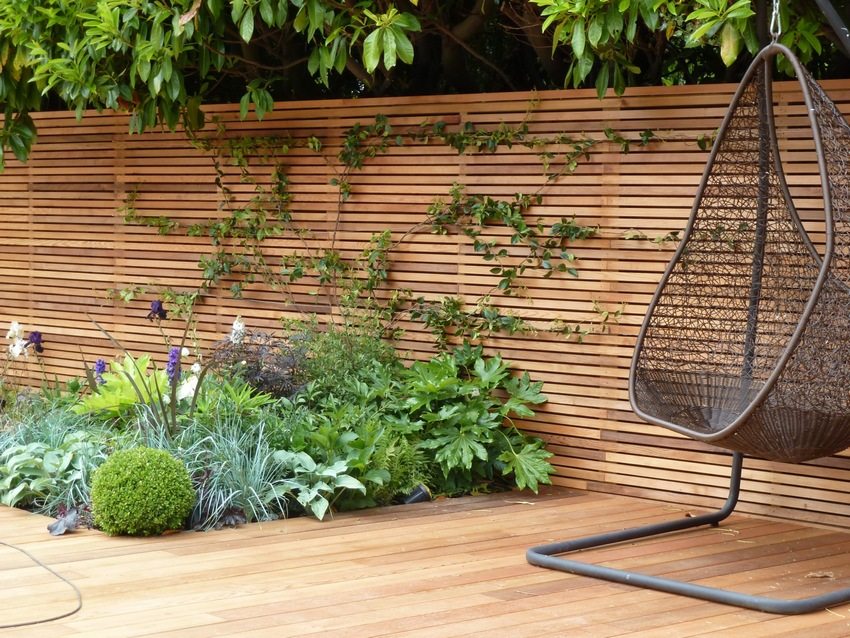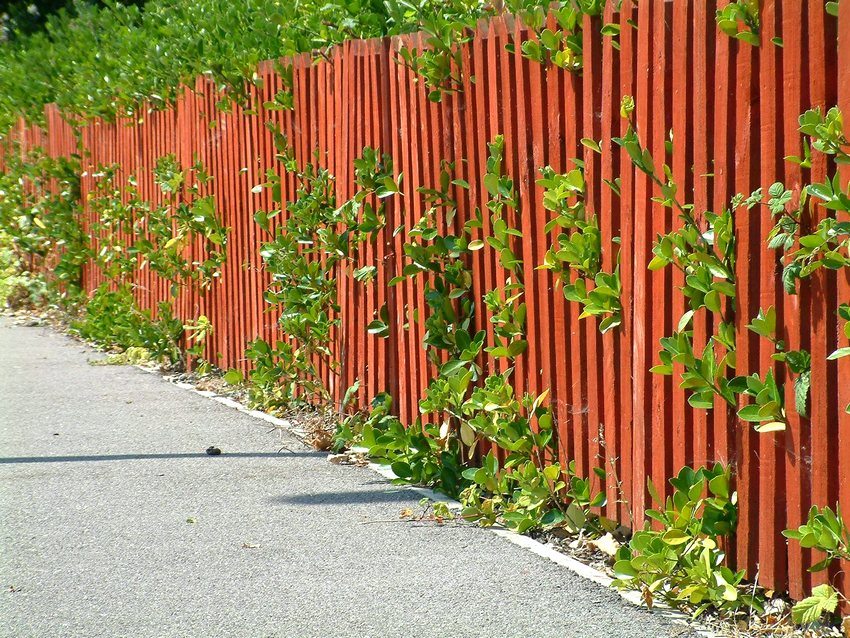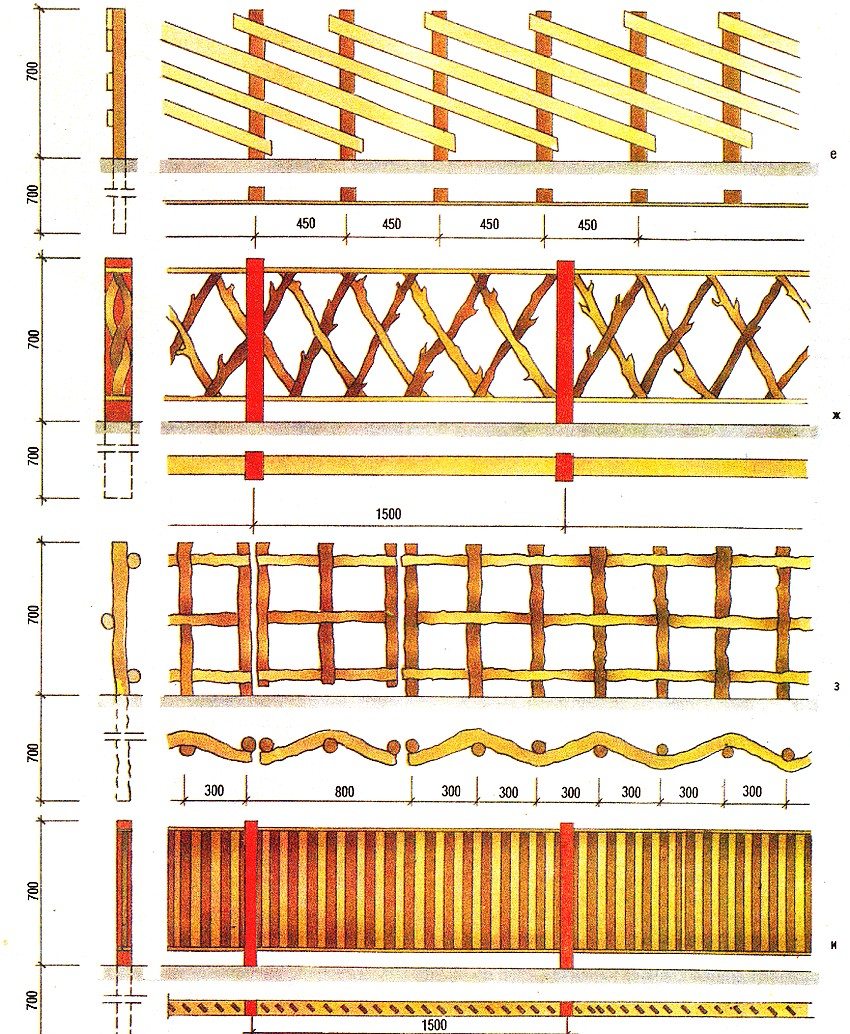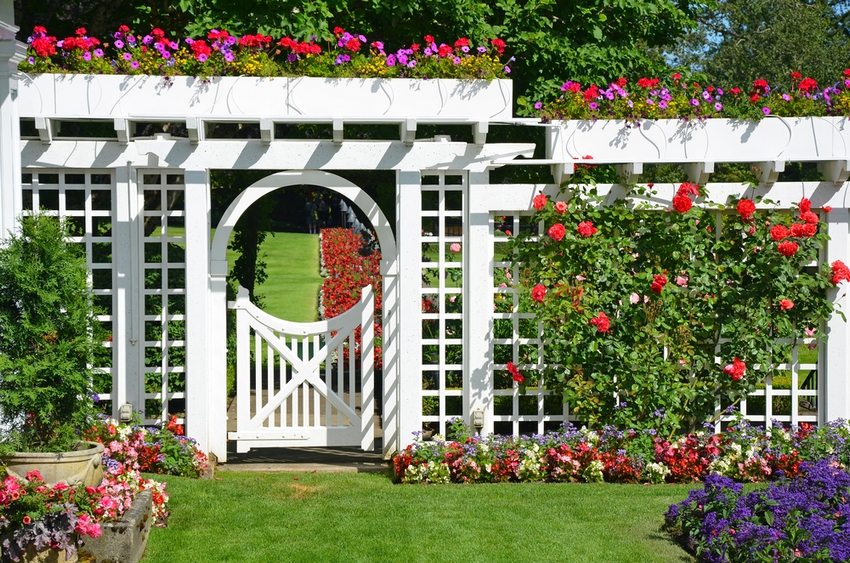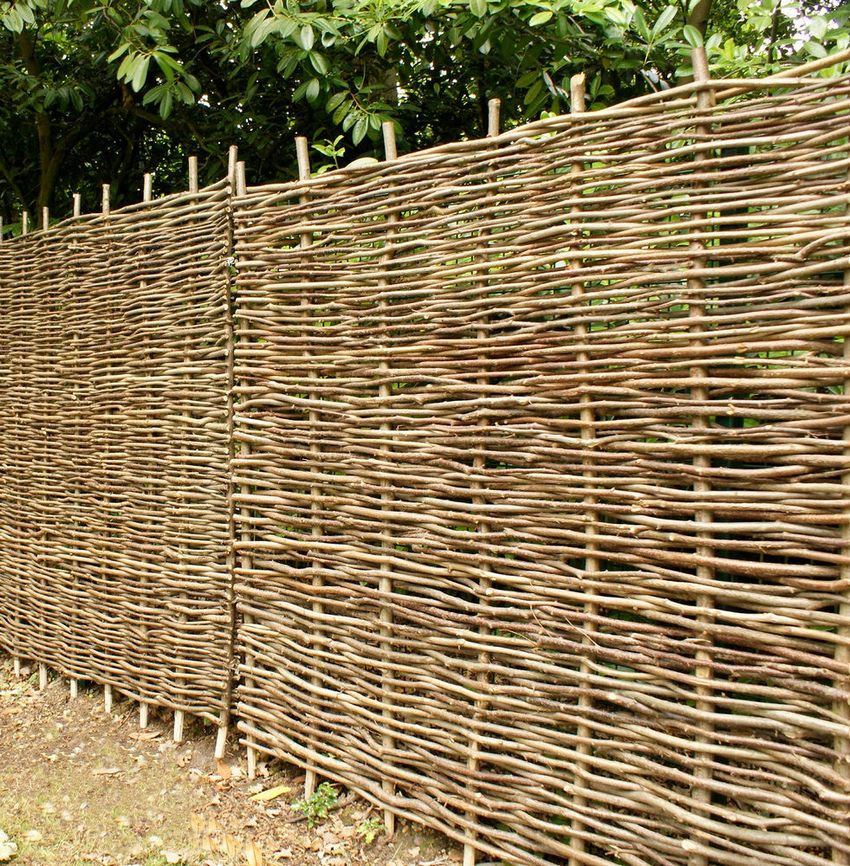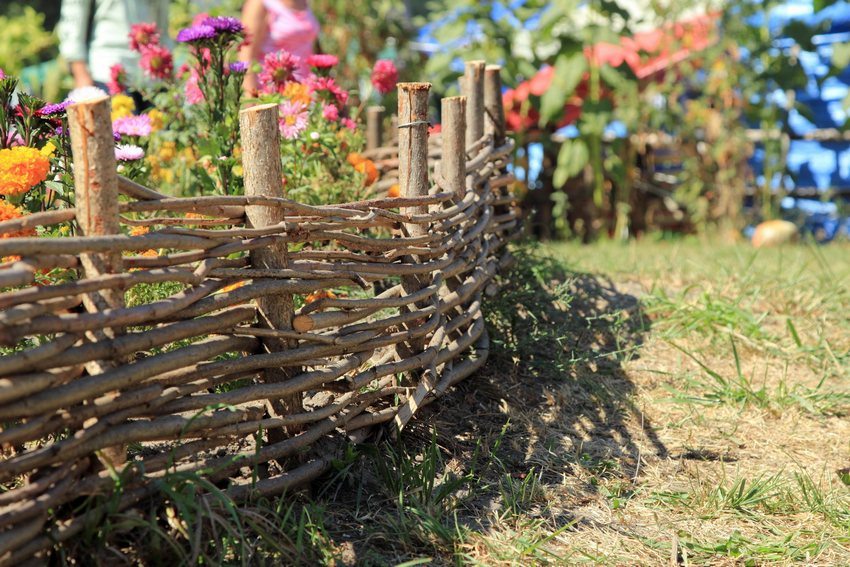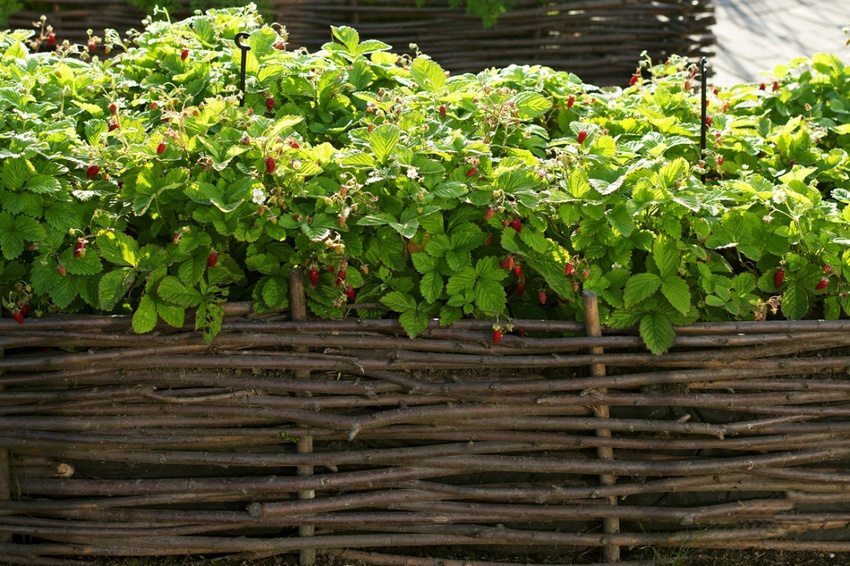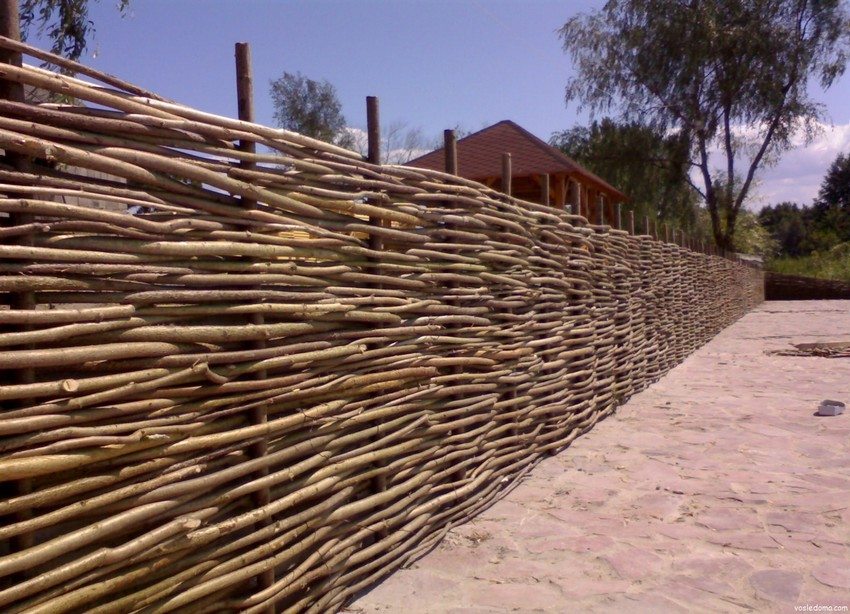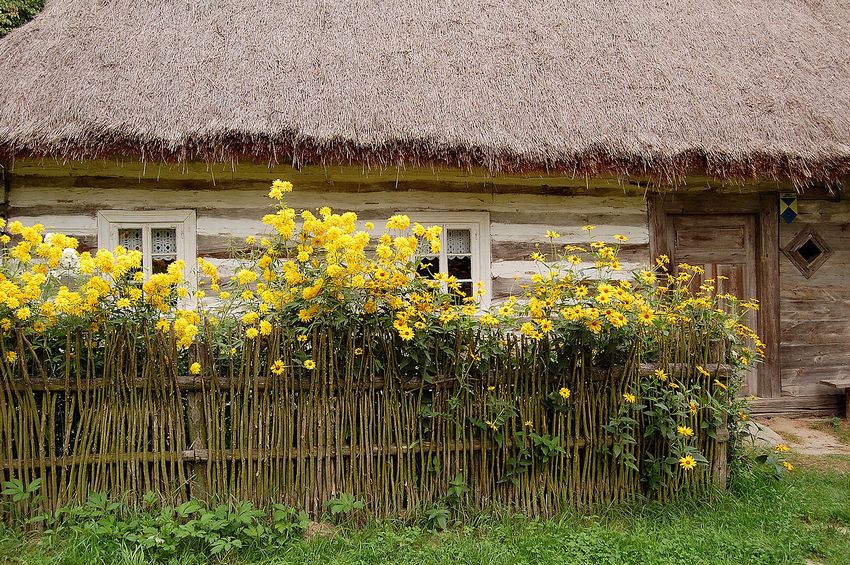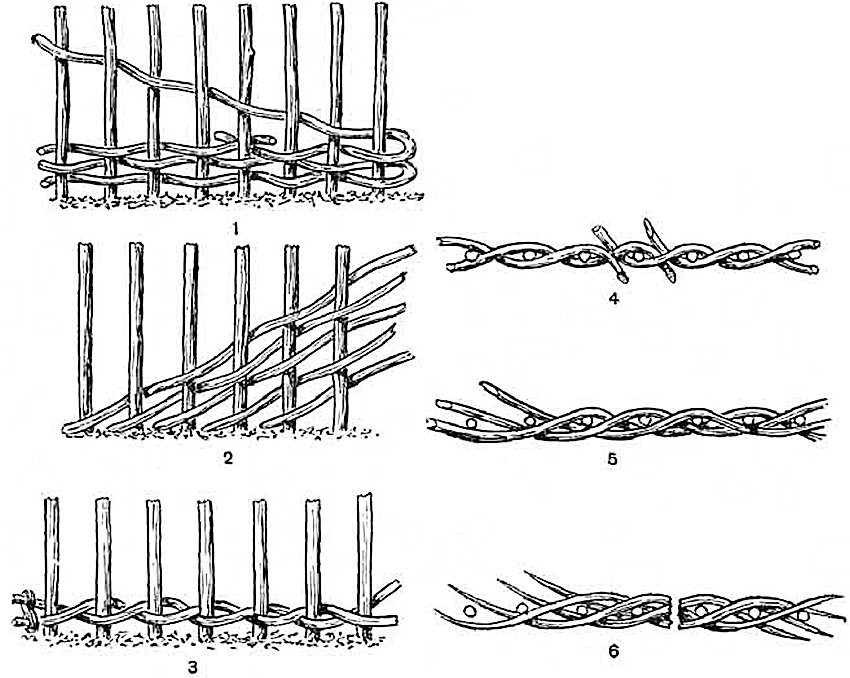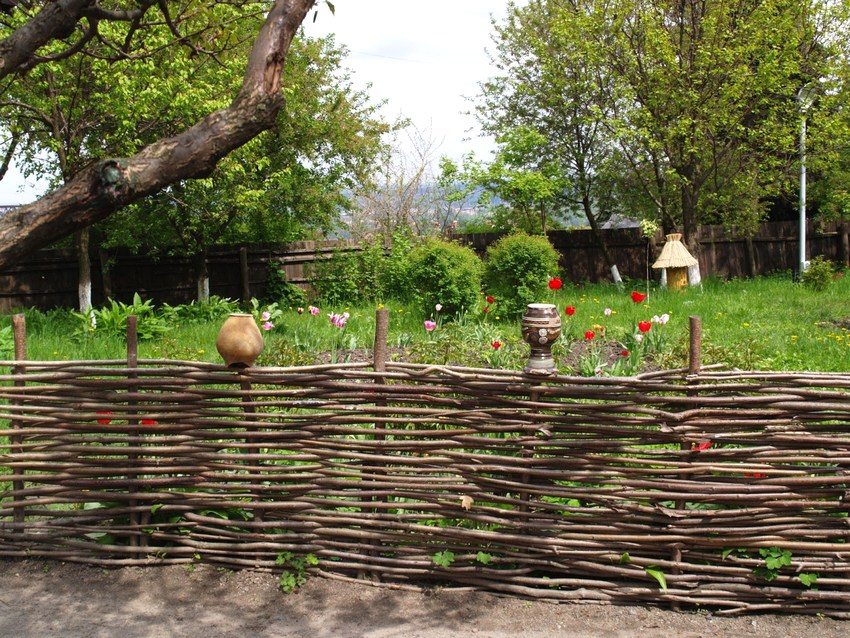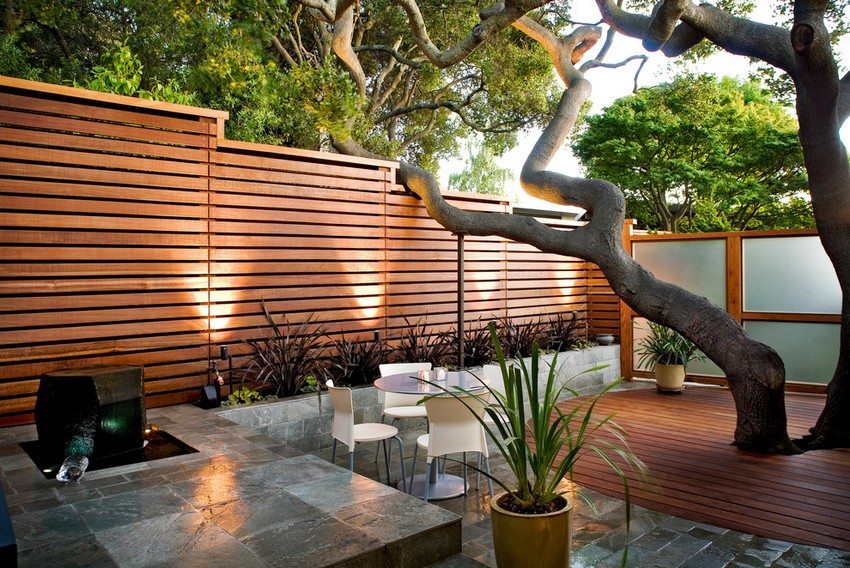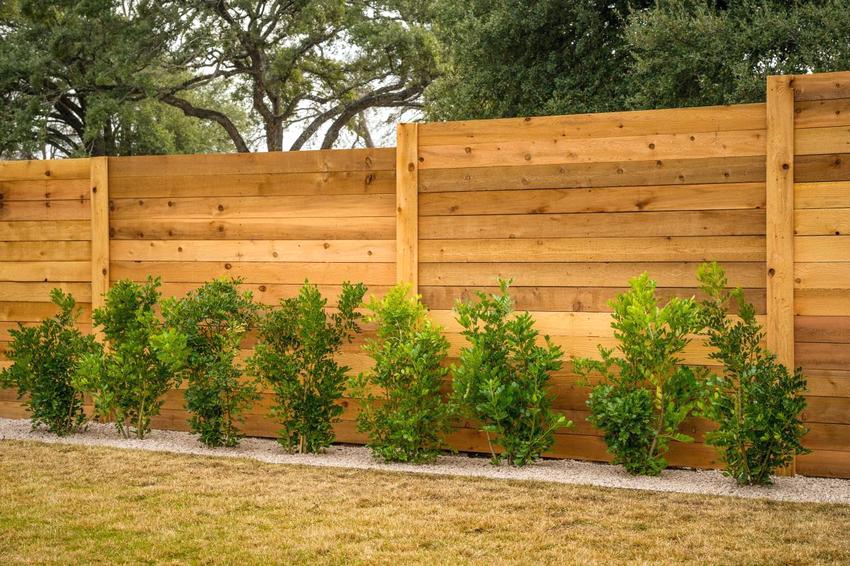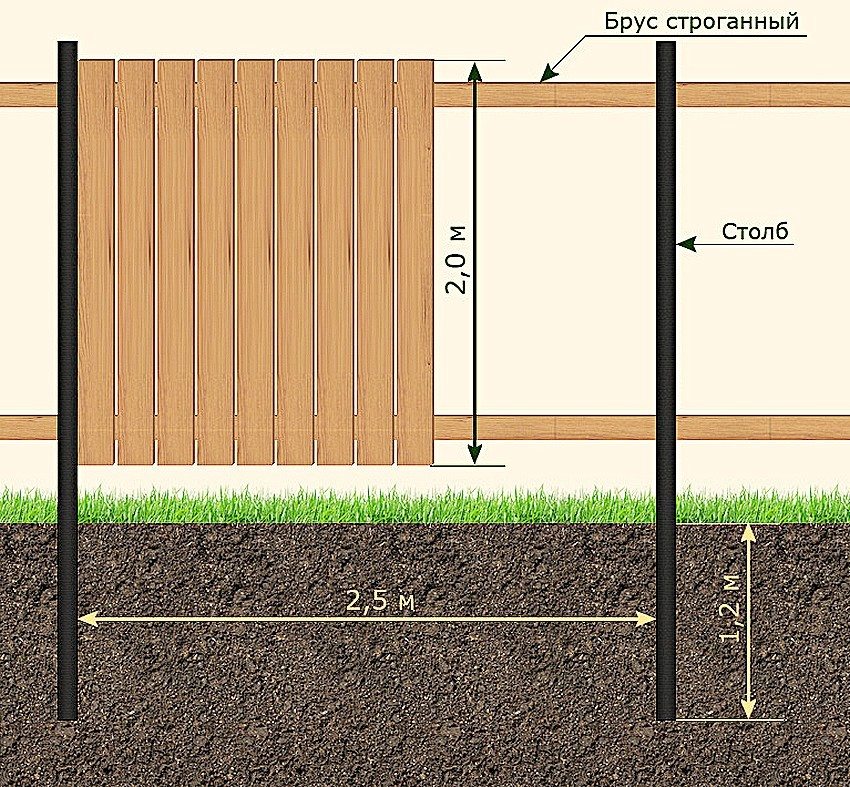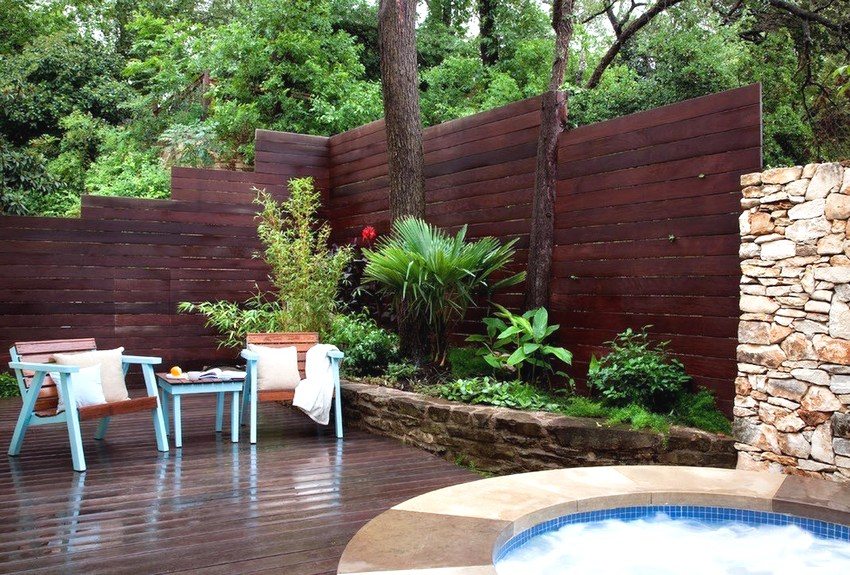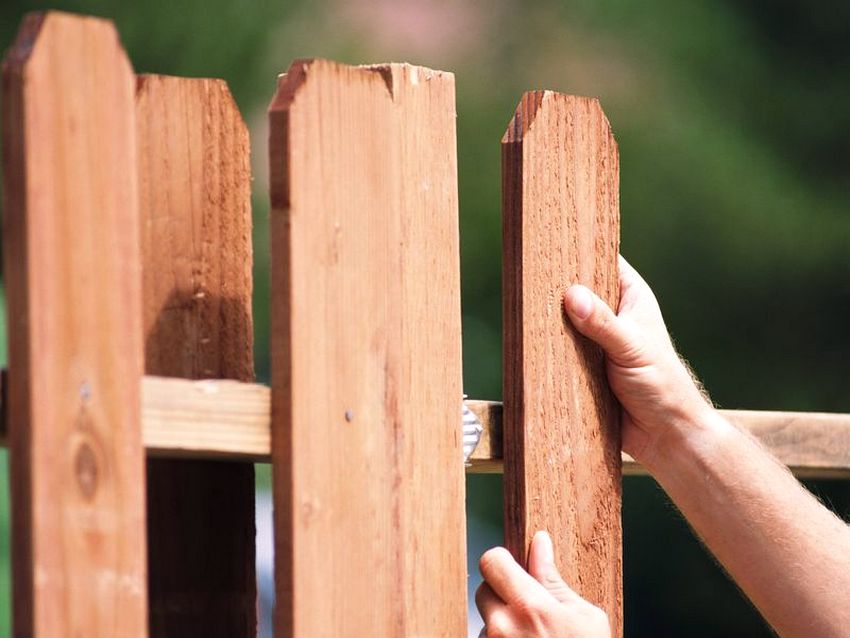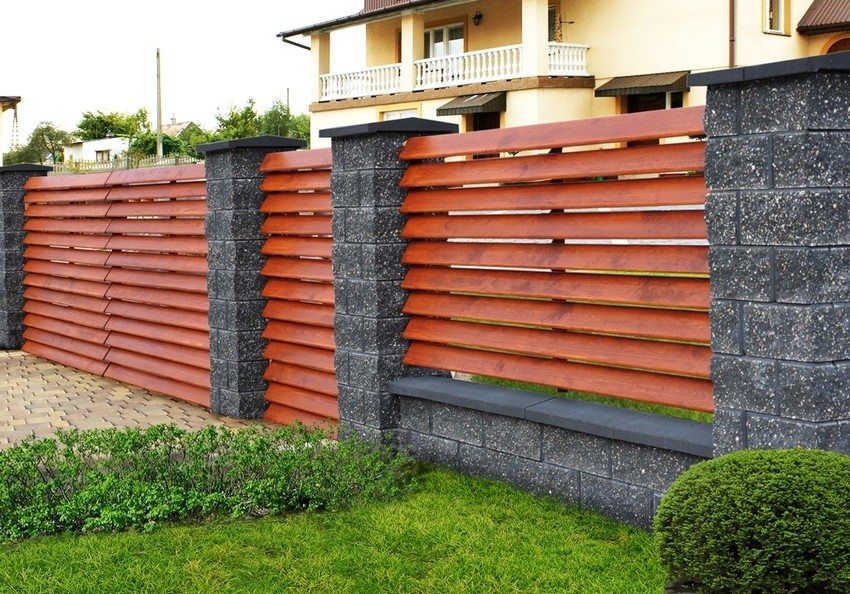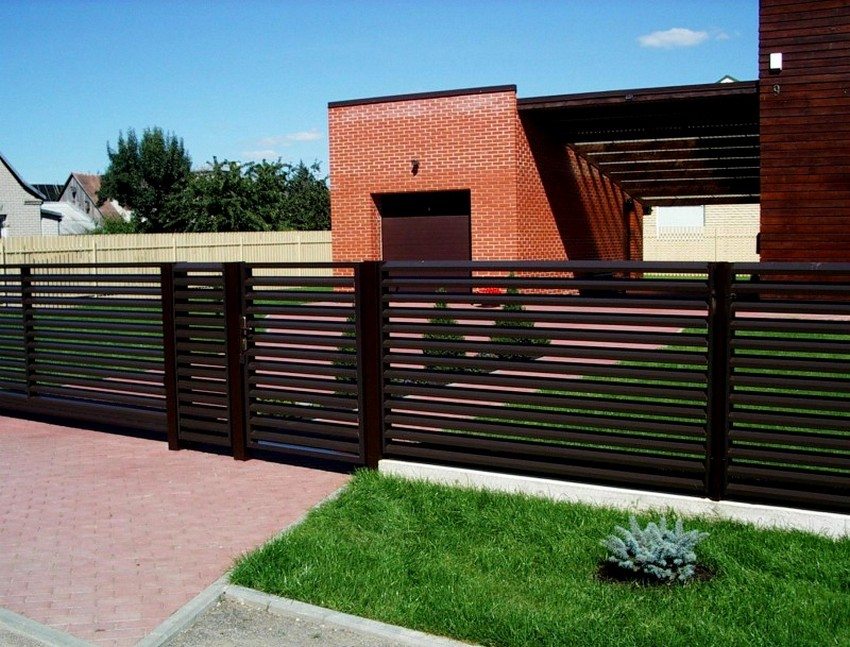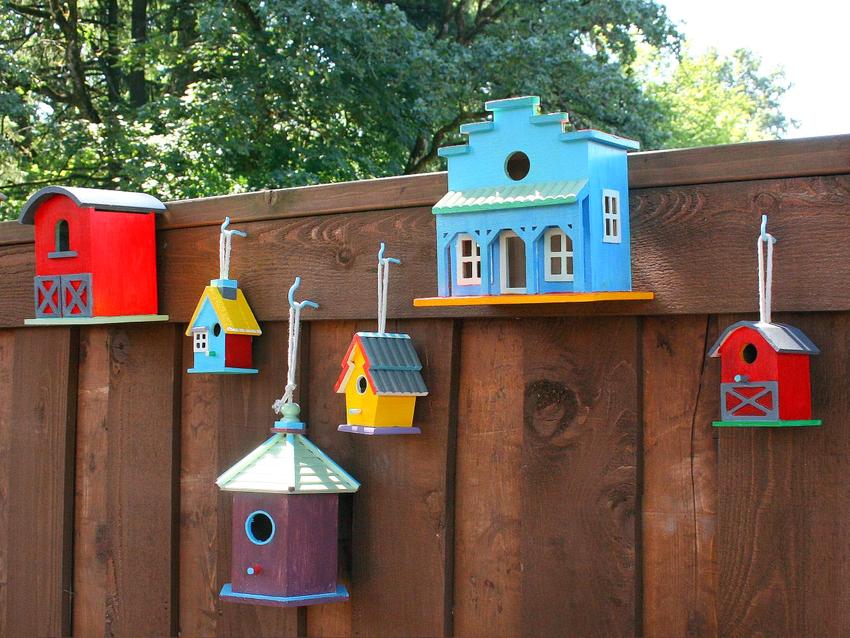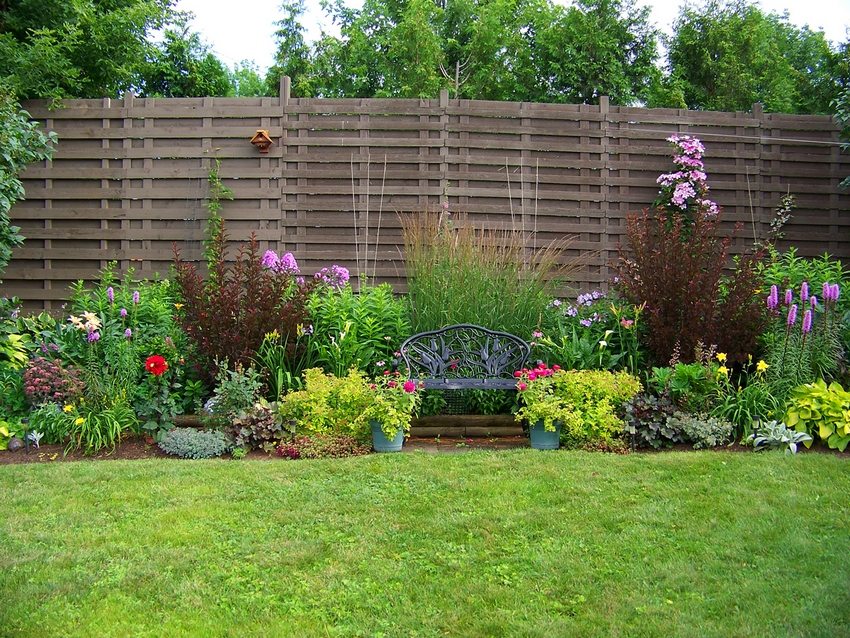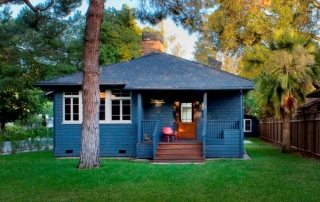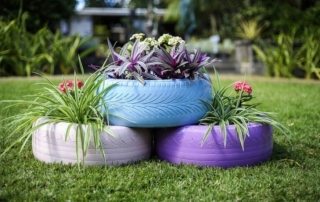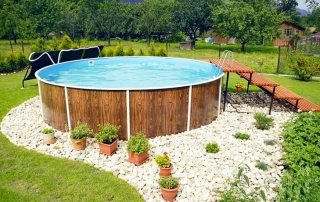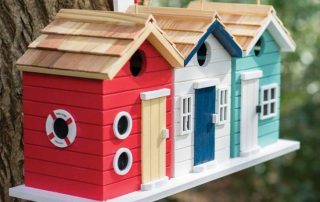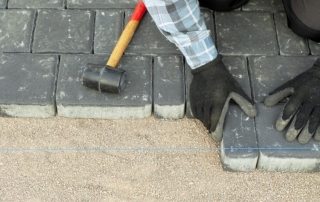Wood has been and remains a popular material in construction. The owners of private houses use wood for the construction of gazebos, sheds, summer kitchens and other structures. The environmental friendliness of this material, excellent malleability to processing and a sufficient service life make it easy to build a fence made of wood with your own hands. The forms of modern wooden fences have a decent appearance and perfectly complement the exterior of the home ownership.
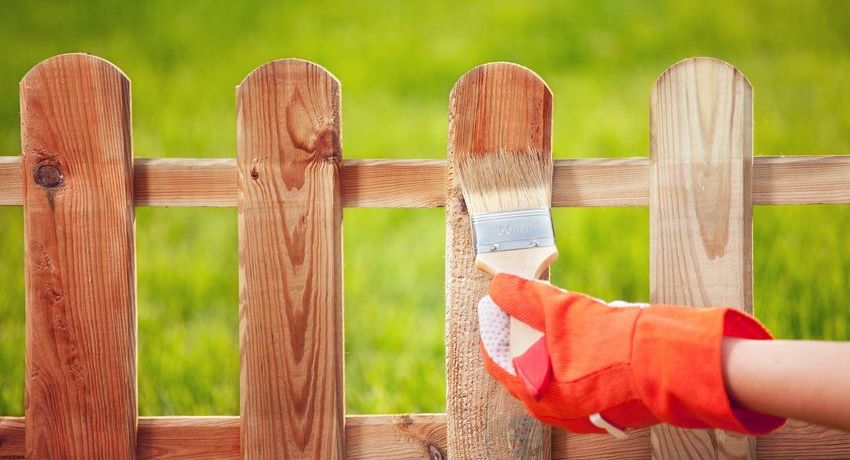
Due to its ease of processing and high environmental friendliness, wood is a popular material for fences.
Content
DIY wood fences. Photos of current options
Wooden fences, framing the territory of personal plots, can take various forms. For their construction, timber, edged and unedged boards, logs, planks, as well as twigs and branches of trees are used. Fences can be solid or with gaps, with elements arranged vertically, horizontally, at an angle, in one or two rows, with even and wavy edges, as well as with inserts of various patterns.
The most popular are such options for do-it-yourself wooden fences, photos of which clearly illustrate their design:
- "Ladder" or "Herringbone" - this type of fencing is characterized by the arrangement of horizontal boards between the supports at a certain angle and overlap. Outwardly, this design resembles blinds: the space behind fence not visible, and oblique gaps allow air and light to pass through;
- "Chess" - fencing, in which the vertical elements are stacked in two rows, shifting them in a checkerboard pattern. In this fence, both sides are front. Fence reliably covers the yard from prying eyes and at the same time has gaps that are visible only at a certain angle;
- "Picket fence" is a traditional type of fence, where vertical strips are attached to the guides with a certain pitch. You can add an attractive look to the railing with the design of the top edge fence in the form of a wave or zigzag. The popularity is due to the ease of installation and economy;
- "Lattice" is an original type of fencing, consisting of wooden frames, inside which there is a lattice of strips. Such fence it can be made in one or two rows with a different pattern of crossing the strips. It has a light and delicate appearance, it is used as a decorative type of fencing;
- "Braid" is an original fence construction, obtained by weaving boards horizontally or vertically. Erecting a wicker fence with your own hands is not a big deal, the costs for it are low, and the appearance is quite decent. Wicker hedges made of branches or twigs, mainly used for decorative framing of small summer cottages, have come into fashion.
This is not a complete list of wooden fences. Many make fences, combining in one design fence and trellis, or combine wood with metal, stone, brick and other materials. You can get an original and inexpensive design by building a fence from an unedged board with your own hands. Photos of such designs illustrate the individuality and ingenuity of their manufacturers.
DIY wooden fence: useful recommendations
In order for the design of a self-installed fence made of a wooden picket fence or another type of fence to be strong and durable, you should adhere to some recommendations:
- the support posts must be mounted using special shoes to expand the support area, which will ensure the rigidity of the structure;
- vertical posts should be placed in increments of 2.5-3 m;
- the vertical and horizontal of the mounted fence elements must be checked with a building level;
- wood processing with antiseptic compounds must be done before installing the fence. When the structure is assembled, some places will become inaccessible for processing, and therefore vulnerable to the actions of pests;
- protect the wooden fence from the effects of precipitation and sunlight. Remember that you need to paint the wooden surface after thoroughly drying the material;
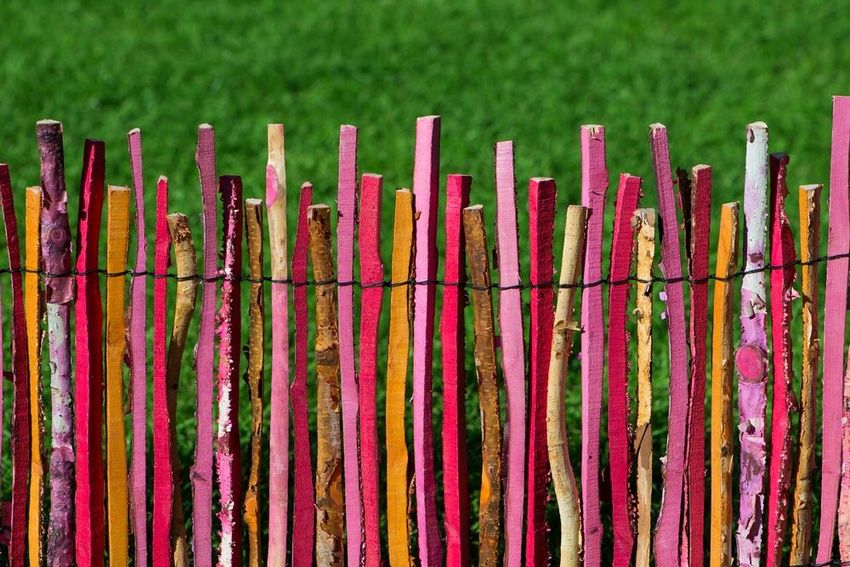
Original fence around the territory of a country house
- it is not recommended to use oil paints and varnishes for painting wooden fences: under the influence of natural factors, such a coating peels off and crumbles;
- to fix the elements, it is advisable to use fasteners with a galvanized coating, which are not very susceptible to corrosion;
- make sure that when using screws and nails, they do not damage the structure of the tree.
Adhering to these recommendations, you can avoid common mistakes when installing a wooden fence in the country with your own hands. Photos of self-erecting wooden fences, found in a large number on the network, demonstrate the various stages of work.
Do-it-yourself wicker fence. Photo of fences in a rustic style
Do-it-yourself decorative fences made of wood have become popular recently. Photos of such fences show that their main purpose is not protection, but symbolic stylized framing and decoration of the personal plot or a small area of it. Wicker fences are quite simple to build. After studying the step-by-step instructions, you can find out how a wicker fence is made with your own hands.
Types of wicker fences
Depending on the height, weaving method and purpose, wicker fences can be divided into several groups:
- up to 1 m high - low fences with horizontal weaving. They are installed to frame floral flower bed, large tree trunks, wells, as well as for marking paths;
- height from 1 m to 1.5 m - horizontal or vertical weaving is used in such a fence.They serve to delimit the territory into separate zones, for example, with their help, you can separate the recreation area from the vegetable beds or allocate the garden space;
- up to 2 m high - can serve as a protective fence and are installed along the outer perimeter of the personal plot. Here, both horizontal and vertical weaving can also be applied.
Useful advice! To make the wattle last as long as possible, choose hazel or vine for its manufacture. Such a hedge will last over 10 years.
Careful processing of raw materials with an antiseptic solution will help to extend the service life of a do-it-yourself fence from the branches of a wicker fence.
Preparation of materials and tools
To build a wicker fence with your own hands you will need:
- metal or wooden stakes;
- willow vine stems;
- sledgehammer;
- pruner, knife, wire.
The twigs are harvested in spring or autumn, choosing the straightest branches as possible. Once harvested, the shoots must be dried and bunched for storage. Before the device of the fence (15 minutes before weaving), to give flexibility to the rods, they are thoroughly soaked or steamed. After laying, the woven branches dry out and acquire a solid structure.
Wooden or metal stakes are prepared for the frame. To prevent the supports installed in the ground from rotting, a trench is prepared along the perimeter of the future fence and its bottom is covered with sand. Due to this, moisture will drain and quickly pass through the sandy base into the ground.
Useful advice! To give the structure of the wicker fence strength, it is recommended to deepen the support stakes by at least 0.5 m.
Frame device and hedge weaving
The frame of the fence is made of stakes located at a distance of 50 cm from each other. It is this distance that will contribute to the comfortable weaving of the vine. In places where the fence line ends, the installation of wooden fence posts is carried out with a smaller step. This allows you to properly fix the ends of the braided rods.
If the future structure will have a height of more than 1 m, metal rods are used instead of wooden stakes. They are pre-painted in a color that imitates wood. Such a frame will be more rigid, and also more resistant to the effects of a moist environment in the soil.
If horizontal weaving is chosen, it starts from the bottom row and ends at the top. The supporting pillars are wrapped in a vine in the form of a "figure eight". In order for the fence not to warp, it is necessary to nail the upper ends of the wooden supports to a flat bar, which is removed before weaving the last row. To give the fence an aesthetic look, you need to make sure that the ends of the branches are located on the back of the fence.
In order for the fence made of rods to be strong, it is necessary to tie the ends of the rods together with wire. The protruding ends are cut with a knife or pruner, and the remaining parts of the rods of the last row are tucked along the support pillars.
For a more natural look, rods of various lengths are used, thereby masking the joints.
Do-it-yourself fence device from boards: photos, stages of construction
You can build a fence made of wood with your own hands using a board with a section size of 15x2.5 cm. The length of the board is selected depending on the height of the planned fence. Traditionally, fences with a height of 1.5 to 2.5 m are installed.
Preparatory work
The first step is to mark the fence line.For this, small (50-60 cm) stakes are hammered along the entire perimeter of the personal plot with a step of about 2 m. A construction cord is pulled between the pegs. When tying the stakes, it is necessary to ensure that the cord is sufficiently stretched and does not sag. Then you will need to prepare the boards of the required length.
You can cut the boards yourself or order ready-made material of the required length. All boards are ground on a machine or using a grinding attachment on a drill. The ends of the boards can be left flat or trimmed into a semicircle or triangle. By processing an unedged board with your own hands, you can significantly save the cost of building a fence.
For the supports, a wooden bar is prepared with a section size of 75x75 mm, 50x50 mm. The number of beams is calculated based on the total area perimeter. For guides, boards with a section of 10x2.5 cm are used.
How to install fence posts
Before installing the support pillars, you need to drill holes to a depth of 0.5-1 m in those places where the stakes are dug. Pits are made with a drill (manual or electric). For vertical racks, a bar with a section of 75x75 mm is used. Before installing the supports, it is necessary to well process that part of the timber that will be in the ground.
Processing is carried out by keeping the lower parts of the wooden supports in an antiseptic impregnation for 48 hours. After this, the pillars must be well dried.
Additionally, you can protect the wooden rack from rotting by concreting. The bottom of the pit is covered with a small (1/3 of the depth) layer of sand and crushed stone, poured with water, a beam is installed and poured with concrete. Until the concrete has set, the support is raised slightly to allow the mortar to penetrate under the base of the post. Further, using a plumb line or level, the timber is installed vertically.
In order to make sure that the height of all vertical supports is the same, it is necessary to hammer a nail into the upper end of each bar and pull the cord tightly between them. The resulting line will show how correctly the height of all supports is selected. For complete drying, each support is given at least three days.
Board fence device
When all the vertical supports are installed and aligned, proceed to the installation of the horizontal guides. They are usually located 25-30 cm above the ground level and distributed at an equidistant distance from each other. For fixing, nails are used, the length of which will allow you to break through the beam and the board through and at the same time 1.5-2 cm will protrude from the back side. These protruding ends are folded neatly along the wooden plane.
Next, proceed to the boarding. For fastening, nails or screws are used. At your request, you can mount the boards close to each other or leave some gap. As soon as the fence is finally assembled, the tree is covered with linseed oil, allowed to dry well and painted with a compound that is resistant to environmental influences.
Wooden fence "Yolochka"
The wooden fence "Yolochka" is very popular and aesthetic. To independently assemble such a structure, you will also need to mark the perimeter line and install vertical supports as described above.
The main feature of the Yolochka horizontal fences is the arrangement of the boards at an angle and overlapping. To achieve such an arrangement, it is necessary to fix wooden lining (in the form of steps) to the vertical posts or use a channel into which you can easily insert the board at a slight slope. In addition, boards can be positioned not only horizontally, but also vertically at an angle.
Related article:
Beautiful fences for private houses: photos of interesting fences. Types of fences, photos of various options. Wooden fences. Metal enclosing structures. Structures of stone, brick and concrete.
The filling of the horizontal fence frame starts from the bottom row. The board is attached to the uprights and guide rails. Next, the next row of boards is overlapped.
Useful advice! To obtain a fence with small gaps, as well as to ensure ventilation, a cushioning material is placed between the boards.
The end edges of the boards must be carefully leveled. So, row by row is installed and after each run the edges are aligned. Before fixing, it is necessary to treat the boards with protective compounds and apply a double layer of paint.
Features of the fence "Chess"
Wooden fence "Chessboard" due to the fact that the boards are attached from the front and inside, has a more attractive appearance. Such a fence can also be laid horizontally or vertically. The position of the guide beams also depends on this. The distance between the boards is chosen independently and the fence can have small gaps or be solid.
After installing all the vertical supports, the guide beams are fixed. For ease of installation, grooves for crossbars are arranged in the support posts. If metal supports are used, the corners are welded to them, on which the beams are placed.
To get the exact staggered arrangement of the boards, it is necessary to first outline the attachment points for each board. Such markings allow you to get a perfect filling of the fence section, eliminating the possibility of the formation of various gaps between the boards.
The chess fence, made of horizontally or vertically laid unedged boards, looks quite original.
Following the simple recommendations and advice of experts, you can assemble a beautiful and durable wooden fence with your own hands, which will serve as a fence for over 10-15 years.
